Copyright, Jaci Rae and North Shore Records, Inc.
The History of Christmas Cards
Original page and story written by Greg Livaudais
Our modern day greeting card can trace its origin to a card printed in December 1843. At Christmas time Sir Henry Cole would hand write greeting and best wishes to his family, friends and acquaintances. But this got to be a cumbersome task so he asked a friend to produce for him a card with a single message that could be duplicated and sent to all on his list. John Calcott Horsley printed and hand-colored 1, 000 copies of this 'first commercial Christmas card', of which only 12 are known to still exist.
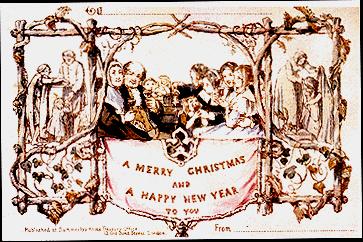 The card depicted three scenes. The center scene was a family gathering around a table with the Words "A MERRY CHRISTMAS AND
A HAPPY NEW YEAR TO YOU" written across a banner covering the bottom half. The left side illustrated feeding the hungry and the right side
was clothing the naked. This caused such a stir with the public that the cards were withdrawn from sale. But the practice of sending cards
caught on and spread to the United States.
The card depicted three scenes. The center scene was a family gathering around a table with the Words "A MERRY CHRISTMAS AND
A HAPPY NEW YEAR TO YOU" written across a banner covering the bottom half. The left side illustrated feeding the hungry and the right side
was clothing the naked. This caused such a stir with the public that the cards were withdrawn from sale. But the practice of sending cards
caught on and spread to the United States.
More about this card can be found at A VICTORIAN CHRISTMAS
Unfortunately, this card is not in my collection.
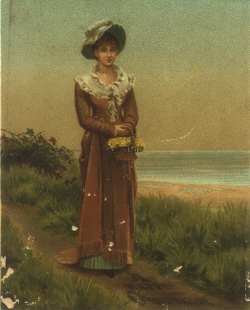 As the postal system developed and improved people liked the idea of sending cards through the mail. A new industry was created
and manufacturers such as Raphael Tuck and Sons begun printing cards with a large variety of designs. The
price range for these cards was just as wide. In 1893 Queen Victoria granted Tuck and Sons a Royal Warrant
and the company then produced Christmas cards especially for the royal family. Tuck and Sons also continued to produce cards for
the general public well into the 20th century. The card on the right is a Tuck card.
As the postal system developed and improved people liked the idea of sending cards through the mail. A new industry was created
and manufacturers such as Raphael Tuck and Sons begun printing cards with a large variety of designs. The
price range for these cards was just as wide. In 1893 Queen Victoria granted Tuck and Sons a Royal Warrant
and the company then produced Christmas cards especially for the royal family. Tuck and Sons also continued to produce cards for
the general public well into the 20th century. The card on the right is a Tuck card.
Meanwhile, in the United States, most early Christmas cards were imported from Great Britain and Europe until 1875. It was at this time that Louis Prang introduced the commercial printing of cards in the United States. Louis Prang, a German lithographer, migrated to Boston in 1850. He became an immediate success because of his innovative color printing process, which used up to 20 plates.
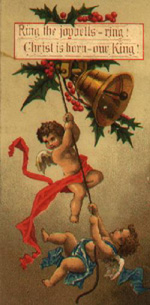 Prang became known for printing seasonal cards the celebrated Christmas, Easter, Thanksgiving and
Valentine's Day. His early cards followed the typical British themes, incorporating humor, flowers, children, animals, and elegant ladies. Many were adorned with ribbons, lace, and flowers
Often his Christmas cards are mistaken for Valentine's or Easter cards because they have scenes unrelated to Christmas. It appears to me that the same card
could have been used for several occasions; just by switching a plate with a different message would turn a Christmas
greeting into an Easter greeting.
Prang became known for printing seasonal cards the celebrated Christmas, Easter, Thanksgiving and
Valentine's Day. His early cards followed the typical British themes, incorporating humor, flowers, children, animals, and elegant ladies. Many were adorned with ribbons, lace, and flowers
Often his Christmas cards are mistaken for Valentine's or Easter cards because they have scenes unrelated to Christmas. It appears to me that the same card
could have been used for several occasions; just by switching a plate with a different message would turn a Christmas
greeting into an Easter greeting.
In the 1880's Christmas cards reflected the taste of the Victorians. Some of the most popular cards were quite bizarre
novelty cards with silk fringe, glitter adornments, and velvet and satin pieces. Some were mechanical; they had
moving parts. A person could move a tab to reveal a hidden message.
Prang's cards were the most popular on the 19th century market. They were not the cheapest of their time, with prices ranging from .75 to $1.25. Price was based on the value of the material used. He kept producing
more and more beautiful cards over a 20 year period. To stimulate new ideas for cards Prang sponsored a contest
whereby artist would submit a design in hopes of winning a cash prize. A panel of judges selected the final designs and awarded
the cash prizes beginning at $1, 000!
The popularity of greeting cards became so large that the market was being flooded with cards from many
manufactures. They were cheaper and of less quality but greater novelty. Prang became frustrated with these
cards of inferior workmanship that were taking away his market share. So he abandoned the business in the early
1890s. His beautiful cards are sort after by many collectors and museums.
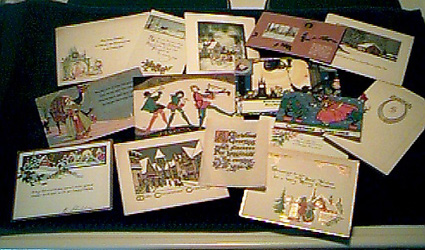 In Victorian days it was customary for middle and upper-class Americans to leave a 'visiting card'
when making a formal visit to another's home. Publishers Charles Goodall & Sons printed such cards and expanded
its business by printing special cards for the holidays.
In Victorian days it was customary for middle and upper-class Americans to leave a 'visiting card'
when making a formal visit to another's home. Publishers Charles Goodall & Sons printed such cards and expanded
its business by printing special cards for the holidays.
These cards were ornate, usually in the shape of a basket of flowers. Ribbons were attaches that opened the flowers when pulled, reveling messages of health, happiness, and goodwill. Other had a cord attached so the owner could hand the card for display. Others were placed in ornate frames and displayed as a lovely decoration. Some had pleats, so to be free standing. Eventually Goodall and Sons began producing Christmas cards much like the kinds we send today.
 Famous artist have contributed to the design of Christmas cards.
Clapsaddle is a very popular artist who's signed cards are sort after by collectors. Kate Greenaway, a children's book illustrator, designed many
Christmas cards. Her works are considered masterpieces of greeting card art. The Santa card to the left is
a Clapsaddle illustration.
Famous artist have contributed to the design of Christmas cards.
Clapsaddle is a very popular artist who's signed cards are sort after by collectors. Kate Greenaway, a children's book illustrator, designed many
Christmas cards. Her works are considered masterpieces of greeting card art. The Santa card to the left is
a Clapsaddle illustration.
Production of the modern Christmas card got its start at the 1893 World's Columbian Exposition
in Chicago.
The U.S. Post Office granted Charles Goldsmith a license to print illustrated souvenir cards of the fair on U.S. postals. The modern greeting card industry began soon after. In the early 1900's companies such as Hall Brothers, Inc (renamed Hallmark Cards), American Greetings, Rust Craft and Buzza were established.
The post card boom is credited for much of the demise of the elaborate cards of the early Victorian era. By 1907 the American public was wrapped up in the idea of the 'penny postcard'.
It was inexpensive to purchase and send. Many early American, German, and British Christmas postcards had beautiful illustrations of Christmas scenes that included Children, villages, holly, angles, nativity and even Santa Claus.
It has always been interesting to me to see the many different variations of Santa depicted on
early postcards. In the earliest ones his looks like a woodsman, dressed in brown fur. Later he is
a purple overcoat, and also green, white and blue ones. But the most common color of Santa's outfit is
red.
In 1910 Joyce C. Hall, a determined young man, decided to venture into the mail-order business.
In a room at a Kansas City YMCA, Hall founded Hall Bros.
Postcards had become very popular with Americans, but Hall sensed the business potential for Christmas cards that could be mailed in envelopes. By 1915 he
introduced his first Christmas cards on the market. More history about Hallmark can be found on the Hallmark History Page.
By the 1920's the quality of the postcards deteriorated. They are less elaborate and fine artwork
is harder to find.
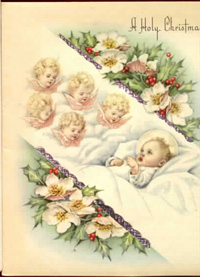 During the 1930's modern greeting card type began to flourish. The front cover had an artistic design and a short greeting.
Upon opening the card the recipient would read a message wishing the best of the season to them. Many are of a religious nature.
Others have a peaceful outdoors scene, a snowbound village and, of course, there is Santa. By this time he is
almost always dressed in red.
During the 1930's modern greeting card type began to flourish. The front cover had an artistic design and a short greeting.
Upon opening the card the recipient would read a message wishing the best of the season to them. Many are of a religious nature.
Others have a peaceful outdoors scene, a snowbound village and, of course, there is Santa. By this time he is
almost always dressed in red.
Today you would have a hard time finding a modern card as intricate and elaborate as those produced during the Victorian era. That was a time of fine artisans and expert printers. They never heard the word 'clip art'. Fortunately many of these cards are preserved in private and museum collections. One of the largest collections of Christmas cards is at the headquarters of Hallmark Cards in Kansas City, MO. Displayed here are not only cards produced by Hallmark, but also many cards from other printers dating back to the 1800's.
You can visit these card companies:
Hallmark Cards is the No. 1 card producer.
The company's cards are sold under the brand names Hallmark, Shoebox, and Ambassador.
American Greetings is the #2 U.S. maker of greeting
cards. The company makes American Greetings, Carlton Cards, and Forget Me Not brand name cards.
Gibson Greetings is a distant 3rd in the U.S. greeting card market. The company designs and markets a
full line of greeting cards, gift wraps, paper party ware, and related specialty products. Products include
everyday cards plus a broad range of special occasion, alternative market, and seasonal cards.
CSS Industries(no web site found), is a maker of seasonal consumer products. Christmas-related greeting cards, gift wrapping, and bows account for almost two-thirds of the company's sales through subsidiaries The Paper Magic Group, Cleo, and Berwick Industries.

